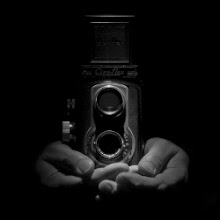 pring there are flowers blooming, and I like it. I have a few different bulb type flowers planted around my home, and tulips are some of those in my yard. I have seen tulips all over our area in full bloom for a good two weeks prior to mine opening up, but I am patient. Flowers in B&W can be tricky to pull off nicely, but I decided to give it a try with my tulips this year.
pring there are flowers blooming, and I like it. I have a few different bulb type flowers planted around my home, and tulips are some of those in my yard. I have seen tulips all over our area in full bloom for a good two weeks prior to mine opening up, but I am patient. Flowers in B&W can be tricky to pull off nicely, but I decided to give it a try with my tulips this year.Over the past week of waiting before mine fully opened, I have thought about how exactly I wanted to shoot them. Heck, I have cameras-a-plenty in all the formats, but I decided on using my Century Graphic press camera since it takes sheet film. I really like the concept of sheet film. You can shoot just one or two sheets if you want. This is nice since it cuts down on wasting film and allows you to process right away, and it can cut down on the wait time while a roll is being finished. Besides, these are tulips. How many shots could it possibly take to artfully capture an arrangement of tulips on B&W film? I'm pretty sure I don't need a dozen or more shots to get the scene I have in my mind.

For the studio setup I kept it simple. One translucent umbrella with a modeling light (left side), an all black drop background draped over the table that was holding the vase of tulips. For this camera I have a few choices for film -Fomapan 100, Efke50, Efke100. I went with the Fomapan 100 since I really like how it looks in D-76 1+1. My stock D-76 is aging, so I took this opportunity to use some of it. For the camera setup, there are several ways this arrangement could be shot based on personal preference. I tend to like the deeper focus so I normally shoot scenes like this stopped all the way down. For this one I was set at f32 and 4 seconds on Bulb time to get it recorded on the Fomapan 100.
Another feature of the LF cut film cameras that I enjoy is the way composition is made through the ground
 glass. The subject is upside down, and flipped. To me it makes it simpler to focus on my composition this way compared to a reflex prism viewfinder. The shapes are upside down, and as such it's easier to disconnect from the scenes and pay attention to shape placement on the ground glass. I suppose this seems easier to me since everything really stands out when it's upside down. Our minds record scenes normally when using a reflex prism finder, and for me sometimes I find that I don't pay as much attention to how I am framing a scene since it all looks natural. Then again, this could all be in my head. That's the beauty of photography. There are a million variations, and millions of subscribers to each variation -none are wrong.
glass. The subject is upside down, and flipped. To me it makes it simpler to focus on my composition this way compared to a reflex prism viewfinder. The shapes are upside down, and as such it's easier to disconnect from the scenes and pay attention to shape placement on the ground glass. I suppose this seems easier to me since everything really stands out when it's upside down. Our minds record scenes normally when using a reflex prism finder, and for me sometimes I find that I don't pay as much attention to how I am framing a scene since it all looks natural. Then again, this could all be in my head. That's the beauty of photography. There are a million variations, and millions of subscribers to each variation -none are wrong.




